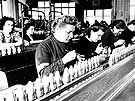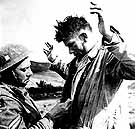
|
|
|

|

|

|

|
|
Click on an image to see a larger, more detailed picture.
|
|
|
|
|
| 1943: Death and Resistance |

|
pg. 454 |

|
|
|
|
| |
 I.G. Farben
I.G. Farben
German business quickly aligned itself with the Nazis and sealed a demonic pact with Heinrich Himmler and the SS. As the most powerful company in the Third Reich, I.G. Farben kept the German war machine rolling, enjoying huge profits in return. From chemicals to explosives, I.G. Farben supplied the Nazis with a vast variety of products. As an incentive to build factories at Auschwitz, I.G. Farben received tax exemptions and the promise of an almost unending supply of slave labor. To seal the deal, the SS agreed to provide I.G. Farben with some 10,000 prisoners as construction workers. From I.G. Farben, the SS gained lucrative contracts that allowed Himmler and his cronies to pursue their own financial goals. By mid-1944 I.G. Farben was Auschwitz's largest employer, with 11,000 slave laborers. Some worked in nearby mines, which supplied the coal for production of synthetic fuel and synthetic rubber. Others were directly engaged in the production of synthetic rubber, known as Buna, at the satellite camp Monowitz. The company was also willing to supply the Nazis' death machine: Through DEGESCH, a company it partially controlled, I.G. Farben provided Zyklon B for the Auschwitz gas chambers.
Photo: Yad Vashem
|
 Female prisoners work in a factory owned by the AGFA company, one of the many companies that belonged to the I.G. Farben conglomerate. German industries that supported the Nazi regime's war effort benefited greatly from their access to forced labor. Hundreds of thousands of people were removed from their homes, relocated to Germany, and forced to work in German factories connected to the war effort.
Female prisoners work in a factory owned by the AGFA company, one of the many companies that belonged to the I.G. Farben conglomerate. German industries that supported the Nazi regime's war effort benefited greatly from their access to forced labor. Hundreds of thousands of people were removed from their homes, relocated to Germany, and forced to work in German factories connected to the war effort.
Photo: National Archives / United States Holocaust Memorial Museum Photo Archive
|
 British and American tank troops continued to score victories in Tunisia even though German troops, led by Field Marshal Erwin Rommel and General Jürgen von Arnim, fought fiercely. News of the huge defeat at Stalingrad, Russia, demoralized some German soldiers, who began to realize that the war might be lost. Here, a German prisoner, captured near Sejenane in northern Tunisia, holds his hands high as he is searched.
British and American tank troops continued to score victories in Tunisia even though German troops, led by Field Marshal Erwin Rommel and General Jürgen von Arnim, fought fiercely. News of the huge defeat at Stalingrad, Russia, demoralized some German soldiers, who began to realize that the war might be lost. Here, a German prisoner, captured near Sejenane in northern Tunisia, holds his hands high as he is searched.
Photo: AP/Wide World
|
|

|

|

|

|
 May 19, 1943: SS chief Heinrich Himmler sends Reich Security Main Office chief Ernst Kaltenbrunner copies of The Jewish Ritual Murder, a book describing apocryphal Jewish religious rituals. Himmler plans to distribute copies throughout Romania, Hungary, and Bulgaria, and broadcast excerpts to England and the United States.
May 19, 1943: SS chief Heinrich Himmler sends Reich Security Main Office chief Ernst Kaltenbrunner copies of The Jewish Ritual Murder, a book describing apocryphal Jewish religious rituals. Himmler plans to distribute copies throughout Romania, Hungary, and Bulgaria, and broadcast excerpts to England and the United States.
|
 May 21, 1943: Three thousand Jews driven from Brody, Ukraine, to a waiting transport train revolt, killing four Ukrainians and a few Germans. Many of the Jews break free after being put on the train, only to be machine-gunned. The remainder are killed upon arrival at the Majdanek death camp.
May 21, 1943: Three thousand Jews driven from Brody, Ukraine, to a waiting transport train revolt, killing four Ukrainians and a few Germans. Many of the Jews break free after being put on the train, only to be machine-gunned. The remainder are killed upon arrival at the Majdanek death camp.
|
|
|
|
|
| 1943: Death and Resistance |

|
pg. 454 |

|
|
The Holocaust Chronicle
© 2009 Publications International, Ltd.
|
|
